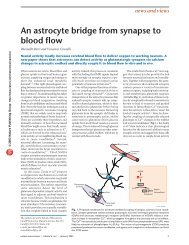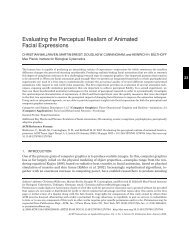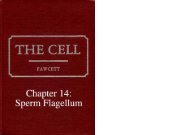Chapter 12: Centrioles
Chapter 12: Centrioles
Chapter 12: Centrioles
Create successful ePaper yourself
Turn your PDF publications into a flip-book with our unique Google optimized e-Paper software.
CENTRIOLES<br />
At the base of the flagellum of a mammalian spermatid, the juxtanuclear proximal<br />
centriole is continuous (at the arrow) with a structure of similar configuration, the<br />
centriolar adjunct. At the end of the latter, there is an accumulation of loose textured<br />
material that appears to be condensing to contribute to elongation of this organelle. The<br />
cavity in the centriolar adjunct is narrower than that of the centriole proper.<br />
At the lower left a transverse section through the centriole (at the level of the white<br />
line in the upper figure) shows the familiar pinwheel arrangement of closed triplet<br />
microtubules. At the lower right a comparable section through the adjunct (at the level<br />
of the black line in the upper figure) reveals some distinctive structural differences.<br />
Subunit a of the triplets is a typical closed microtubule, but b and c are usually open,<br />
presenting a free edge that has failed to fuse with the wall of the adjacent microtubule.<br />
In addition, the centriolar adjunct has a lining layer of complex ultrastructure which is<br />
lacking in the centriole. This accounts for the differences in diameter of their central<br />
cavities.<br />
The formation of atypical triplet microtubules in the centriolar adjunct of spermatids<br />
attests to the capacity of subunit c of the centriolar triplets to serve as a site for<br />
nucleation of microtubule protein. Why it is inactive during generation of an axoneme<br />
so that only doublets are formed remains unexplained.<br />
Figure 314. Implantation fossa, centriolar adjunct, and base of the flagellum in a chinchilla spermatid. Figure 314<br />
(From D. W. Fawcett and D. M. Phillips, Anat. Rec. 165:153-184, 1969.)









